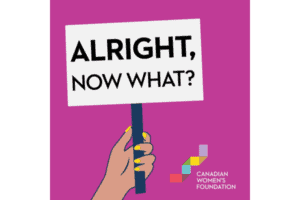 As we move into the holiday season, we have seen more news stories about gender-based violence. For every case we do learn about, there are many we don’t know about. Those facing violence aren’t always safe enough to tell anyone what’s happening. Sometimes, they fear a response of judgement, disbelief, or retaliation. And sometimes the response they get is a complicated mixed bag with both positive and negative elements. Addressing gender-based violence and the gender injustice that underlies it means reflecting on these complexities and paying attention to diverse experiences of survivors. Laura, a friend of the Canadian Women’s Foundation, shares her personal experiences and insights about the key ingredients of a better response to signs and signals of abuse.
As we move into the holiday season, we have seen more news stories about gender-based violence. For every case we do learn about, there are many we don’t know about. Those facing violence aren’t always safe enough to tell anyone what’s happening. Sometimes, they fear a response of judgement, disbelief, or retaliation. And sometimes the response they get is a complicated mixed bag with both positive and negative elements. Addressing gender-based violence and the gender injustice that underlies it means reflecting on these complexities and paying attention to diverse experiences of survivors. Laura, a friend of the Canadian Women’s Foundation, shares her personal experiences and insights about the key ingredients of a better response to signs and signals of abuse.
Content note: this episode features a personal experience of intimate partner violence. If you need access to support, you can find a list of services that may be useful to you on our website.
The Canadian Women’s Foundation acknowledges the support of Women and Gender Equality Canada.
Transcript
00:00:00 Andrea
I’m Andrea from the Canadian Women’s Foundation.
Please listen to this.
00:00:06
I stayed out of it.
I wondered if it was any of my business.
I kept quiet.
I haven’t always known how to help.
But not anymore.
Because if you’re experiencing abuse,
if I see you use the violence at home signal for help, I will text signal to 540-540 to know how to respond.
I will not judge you.
I will know what to do.
I will help you.
00:00:38 Andrea
By now we’ve heard a few stories of people using the signal for help to communicate that they needed support, and they were able to get the help that they needed. That’s really great news. But it also gives me pause. For every situation of abuse we may know about, there are countless others we don’t know about. Sometimes those who face gender-based violence are not safe enough to tell anyone what’s happening. Sometimes they may fear a response of judgment, disbelief, or retaliation. Sometimes the response is a complicated mixed bag, both positive and negative.
Addressing gender-based violence, and the gender injustice that underlies it, means reflecting on these complexities and paying attention to diverse experiences of survivors. It provides so much insight on moving forward in better ways.
Laura, a friend of the Canadian Women’s Foundation, joined us to share her personal experiences and insights about the key ingredients of a better response to the signs and signals of abuse.
00:01:37 Andrea
Welcome to Alright Now What?, a podcast of the Canadian Women’s Foundation.
We put an intersectional feminist lens on stories that make you wonder “Why is this still happening?”
We explore systemic roots and strategies for change that will move us closer to the goal of gender justice.
The work of the Canadian Women’s Foundation and our partners takes place on traditional First Nations, Métis, and Inuit territories. We are grateful for the opportunity to meet and work on this land. However, we recognize that land acknowledgements are not enough. We need to pursue truth, reconciliation, decolonization, and allyship in an ongoing effort to make right with all our relations.
00:02:20 Laura
I’ve learned so much from people’s stories, so I hope you know any story I can share can help others as well.
If I think back to the situation I was in, this is probably in my early 20s I’d say, I was in a relationship for about three years and I’d say that relationship turned pretty quickly into sort of an emotional and even sexually abusive relationship.
You know I was in my 20s, I was actually going to university. I would on the surface or outside looking in, had a great life, really stable family, all of that sort of stuff that you would assume someone has when they have a really solid life.
So I think one of the big concerns I had thinking about sharing what was actually going on, you know, I would have to break this kind of myth really it was around the perception of my life and then I which would then invariably mean I would have to face what was going on in my life at the time. I think I was really concerned about being judged, you know, would people wonder how could I let myself get into that situation?
And you know, and as the months, and years actually, went on too, then it got even harder to think about sharing because then it would also, kind of invariably, I think I felt people would start to question too, why was I staying in this situation for so long? Given you know that I had, you know, a stable family life around me, you know financially I was OK, so in my mind why couldn’t I have had the power to solve the situation?
I think I also had some concerns that if I were to share, there would be this, then instant pressure. Well then I have to leave and I have to leave right away and I just don’t think I was emotionally at a point where I was ready to make that decision.
There was a lot in terms of what was going on with myself and even stemming back to my own childhood around, you know, how I had ended up being in that situation again, and the idea of facing all of that felt really, really scary to me.
So having all of those concerns kind of culminated into me really distancing myself from a lot of different people in my life, some even fully, you know, removing myself from my friendships, especially, because I had all of these kind of feelings that I couldn’t talk about it.
I was afraid what people would say.
Also, just then having to face my own feelings about this situation.
00:04:58 Andrea
Tell me a bit about the kind of response you did get when you did end up reaching out for support, and tell me a bit about the kind of response perhaps that you wish you got.
00:05:08 Laura
Once I finally made that decision, and it kind of culminated into a stranger actually seeing a situation between myself and my partner at the time that escalated it into becoming then known, I guess you can say so then I had to face it, but I have to say there were a few really critical people in my life that were extremely supportive.
Made me feel safe.
One that I think of is my brother and my sister-in-law actually took me in so they, you know, took me out of my apartment and opened their doors and let me stay with them for a few months just so I could feel safe and just to have the space to just heal. I have to say they just intuitively knew that I would come to them when I wanted to talk about things and they just let me take the lead in terms of getting myself through that situation. So that’s one that I really think of first and foremost, as a real support system, and overall , I’d have to say a lot of my family were there for me and allowed me to sort of heal in the way I needed to and determine how they could support me.
Some of what I wish I didn’t have so much experience with, but did invariably happen, as I said, I did distance myself with a few friends so when I tried to reach back out to them and to share a bit what had happened, I did get quite a bit of that questioning that I was expecting, like why didn’t you come to me sooner? Why did you let yourself, let someone do that to you?
All of those kind of questions and I really wish, as in the case of my brother and sister-in-law, I could see more people really just showing up in the way that I needed and making it really about how I can move through that situation as opposed to sort of making it about what they needed out of that situation.
So, I think a bit more coming from a place of, you know, not really judging and how the situation should have been resolved and more just me taking the lead in terms of how I could heal from that, that situation I was in.
00:07:14 Andrea
And that’s what the Signal Responders’ campaign is all about.
We’re trying to give people tools to help them to support people dealing with gender-based violence, in a non-judgmental way, and to center that person’s needs and their experiences first and deal with our own maybe concerns, maybe our feelings and reactions, second?
I’d like to know more from your perspective.
What tools, competencies, skills or traits that you think we need to develop to do this better?
00:07:44 Laura
And I, I’m glad you bring up this guide because I think it is a fantastic tool for those that you know want to understand more how they can be there for the people in their lives that might be coming to them in a similar or in a situation like that and I think the keyword in there is to be non-judgmental.
If I think first and foremost, and I think about it in two different ways, one is in terms of how we can respond to someone when they’re coming to us for help.
And so to try and and remove judgment in terms of how we respond, but also in in how we perceive what, you know, there isn’t one profile of a person that will be in a situation where they are experiencing violence and gender-based violence.
There is no one profile.
So to understand that you know this happens to many different types of people in many different life situations and that we can’t, really, you know, sort of put judgment too around the type of people that this situation happens to. So, invariably, it can mean that there is someone in your life today that could be going through this that you may not know, because again, there is no real one sort of characteristic around a person that is going through gender-based violence.
But I think that if people are listening to this or people are reading about the guide, if I go from a place of positive intent, it’s obvious that you know people are keen and want to help, and I think that’s such a fantastic starting point and a focus point.
And I think it’s human, when we want to help someone, to want to get in and solve it, or to give advice. And I think it’s what I really try to do, and even in situations professionally as well, is to remember and to try and practice or remember the idea that the person that’s in this situation is actually the expert around how they can solve this situation, including who they will reach out to or what’s the right steps for them in their particular situation.
So to come from that place, that always I find really helps me to remember that it’s actually the person that’s going through this situation that is really going to be the one that determines the best course for them. And when I kind of really remind myself about that, it gives me the intention and the place to just really listen. If I think of any skill or characteristic or trait that is so important is just in listening and listening with your heart, listening with your mind, your ears, your body.
I’ve always tried to practice that, again in many situations in my life and it includes, I think, listening also in the silence.
So to just be there, knowing that that person because they have all of the necessary insights into their situation, that they can come forward in terms of determining their best way out of this situation, whatever that might be for them.
00:10:50 Andrea
I like the way you express that, Laura.
The idea of listening to the silence as well too.
Tell us what the silence can tell us.
00:10:57 Laura
I think it tells us the emotions invariably that can’t be said in words, I find sort of comes through in the silence.
It also gives the space for that person to listen to themselves as well. So you’re going to see those kind of thoughts happening and you just can be witness to it, so I think, yeah, there’s so much that actually comes forward in a place of silence.
It can be an extremely powerful space to be in.
00:11:29 Andrea
Do you know how to respond to the Signal for Help? to any sign or signal of abuse?
Go to signalresponder.ca to learn more and text signal to 540-540 to get a Signal for Help Responder’s Action Guide.
We’re in the thick of the 16 days of activism against gender-based violence.
Our November 2021 poll found that 64% of people in Canada know a woman who’s experienced physical, emotional, or sexual assault, but many lack strong confidence and competency in knowing how to support them.
There is no better time to sign up to be a signal responder and get the tools and training we all need.
Go to signalresponder.ca to learn more and text signal to 540-540 to get a Signal for Help Responder’s Action Guide.
Please listen, subscribe, rate and review this podcast and share it with others.
If you appreciate this content, if you want to get in on the efforts to build a gender equal Canada, please donate today at canadianwomen.org and become a monthly donor. And thank you for being tireless in your support for gender justice.






